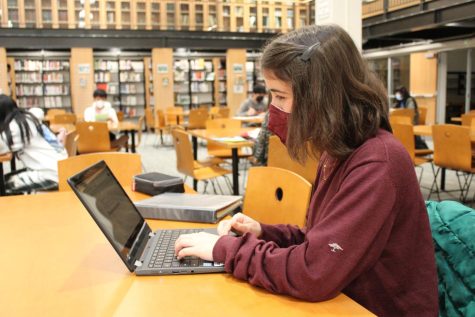Opinion: Wear masks indoors, mandate or not
February 11, 2022
More than 800,000 cases in the United States at the peak of the Omicron surge, just 26 days ago. Since then, current deaths have approached one million with more than 2,600 Americans dying each day from COVID-19.
We are not ready to take off our masks indoors — at least not yet.
Masks are still the most valuable tool in our fight against the virus and have been proven effective again and again in their ability to protect individuals from the virus. Abandoning masks could lead to lasting consequences, and until we reach the point — where cases are low enough and public health authorities deem it acceptable to take off our masks — mandate or not, individuals should continue to mask up indoors.
According to a tweet by Governor Gavin Newsom, California plans to end the universal indoor mask mandate on Tuesday and loosen other restrictions that were put in place in mid-December aimed at lowering the spread of the highly infectious Omicron variant, but Santa Clara County will continue to require masking up indoors.

In the tweet, Newsom cited California’s decreasing covid cases and steady hospitalization rate for the end of the mask mandate, stating “CA’s case rate has decreased by 65% since our Omicron peak. Our hospitalizations have stabilized across the state.”
According to the California COVID-19 Dashboard, masks will still be required in some indoor settings including “in K-12 schools, childcare, and other youth settings.”
Despite lowered case rates, keeping masking requirements in schools and other common public spaces is crucial to keeping cases low and limiting hospitalizations.
The removal of the universal mask mandate does not apply to unvaccinated people — in other words, people who are unvaccinated are still required to wear face coverings indoors. However, this policy relies on the honor system. With the vaccination status of individuals not checked everywhere, we could be encouraging the spread of COVID-19.
As someone with a high-risk elderly person in my family, I feel extremely uncomfortable with the removal of masks indoors. I visit my 80-year-old grandparents’ weekly to deliver groceries and help them with home chores, and the thought of spreading the virus to them is a constant concern. Despite the numerous precautions my family and I take to protect ourselves against COVID-19, we have seen that the virus is capable of evading our defenses and infecting the most vulnerable — at times, causing lasting damage.
While I understand that we are two years into this pandemic and armed with tools such as vaccines, medications, and more than two years of experience and data, the possibility of increasingly infectious variants popping up is still worrying.
Furthermore, without masks, more people have the chance to catch and spread the virus resulting in a greater opportunity for the virus to mutate.
According to a Johns Hopkins Professor of Medicine Stuart Ray, as COVID-19 continues to spread, mutations will happen, and variants — like the omicron variant — will continue to evolve.
“New variants of the SARS-CoV-2 virus are detected every week,” Ray said. “When a change in the infection pattern first pops up, it can be very hard to tell what’s driving the trend — changes to the virus, or changes in human behavior. It is worrisome that similar changes to the spike protein are arising independently on multiple continents.”
Unlike the majority of Bay Area counties planning to lift mask requirements Wednesday, Santa Clara County will keep its indoor mask mandate, for now. According to Santa Clara County Public Health Director, Sara Cody, the county is not yet ready to lift indoor mask requirements.
“We must continue to base our decisions on the risks COVID-19 presents to our community, and we look forward to lifting the indoor mask requirement as soon as we can do so without putting vulnerable people at undue risk,” Cody said. “Universal indoor masking is critical to protect our community, especially community members who are older or immunocompromised.
According to the CDC COVID-19 data tracker, all of California is in CDC’s “high” level of community transmission, meaning that the total number of new cases has exceeded 100 cases per 100,000 people in the past seven days. Although case rates have significantly lowered from the beginning of Jan., the rate of transmission is still very high.
The evidence is clear — now is not the time to begin removing masks.
As cases flux and flow, we should be making decisions based on the science and long-term outcome of them. Just basing them off of a general feeling of fatigue is never how these life-altering decisions should be made.
We know what works: masking up and getting vaccinated and boosted. These policies should not be lifted until the science says we are ready.
In spite of lowered case rates, Centers for Disease Control and Prevention Director Rochelle Walensky maintains that Americans should not remove their masks indoors.
“Right now our CDC guidance has not changed,” Walensky said in an interview with Reuters Tuesday. “We have and continue to recommend masking in areas of high and substantial transmission – that is essentially everywhere in the country in public indoor settings.”


